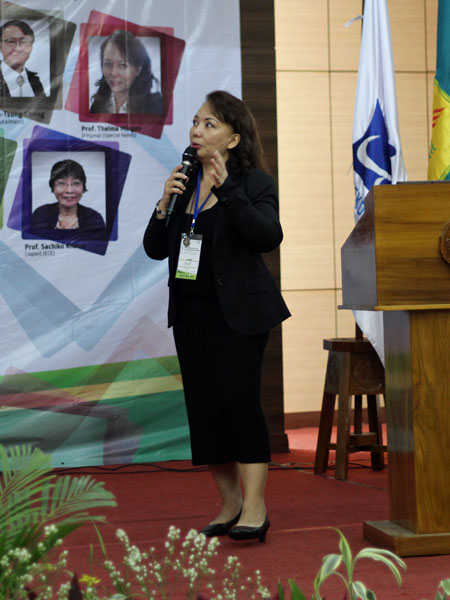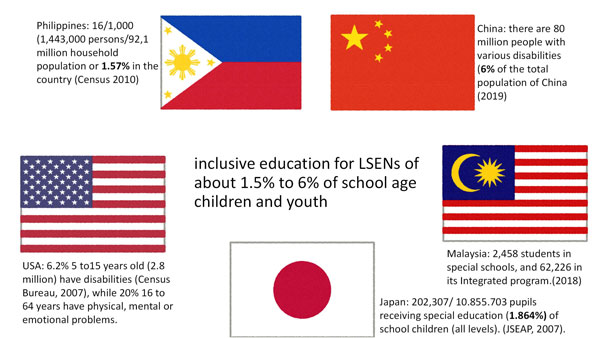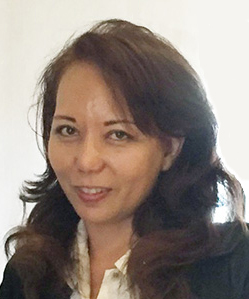* Titles and affiliations are as of the time of the conference.
Presented at Third International Conference of Child Research Network Asia (CRNA) held in Jakarta, Indonesia, September 25-27, 2019.
Lifelong personal well-being

Today I want to talk about cultivating wellbeing through inclusive education.
How many of you are regular education teachers, or special education teachers?
It is said "Lifelong personal well-being is achieved through responsible actions based on healthy attitudes and behaviors." But what does this mean? How is this achieved? What are these healthy attitudes and behaviors? It is important that we don't wait until something happens to us before we become aware, understand or think about what we can do to help others in need. I will share a story with you about something that happened to me about nine months ago. I accidentally sprained my left knee on my way home from school. It was really painful, and for months I had to have all kinds of treatment, wear knee bandages and use a cane, I began to wonder if I would ever walk normally again. Public buildings are required by law to have an access ramp to assist disabled people. I never thought I would need one, but all of a sudden it was essential. However, despite the inconvenience there were some funny moments. Students used to say "we can hear Doc May coming by the way she walks." Once I saw an older person limping like me and I thought "We look like a pair of penguins." Total strangers would offer me assistance and I realized that seeing someone in need brings out the good in people. It somehow makes them feel good.
Today our discussion is about well-being, how we can cultivate it, and how it is related to inclusive education. How can inclusive education help promote well-being of learners with special education needs? What are the benefits for them? What are the benefits of the regular students and staff of teachers? In other words, how is well-being cultivated for ALL in this situation? UNESCO defines 'inclusion' as being about identifying barriers to quality education and finding ways to reduce them. It is a system that caters to diverse learners and supports diversity within the general education setting (UNESCO, 2009). All over the world, great efforts have been made toward inclusion in regular education, for children who are of different color, language, race, religion, socio-economic status, and different abilities or those with disabilities, also called persons with disabilities, or children with special needs, or learners with special education needs. These include those with physical differences (Visual Impairment, Hearing Impairment, Cerebral Palsy, chronic illness, orthopedic problems), neuro-developmental and sensory differences (like autism), cognitive and learning differences (Learning Disabilities, Mentally Retarded, Gifted and Talented), speech and communication problems, socio-emotional and behavior problems. It is important that policy makers understand why there have been problems in making inclusion work. These include things like of bullying and discrimination, lack of facilities, lack of teacher training, and resultant teacher frustration. The question has been raised as to whether we should go for full or partial inclusion or place people in the least restrictive environment (Leatherman, 2007; Rogers, 1993; winter, 1999) where they can thrive. There are different ways of doing things in different countries due to financial, legal and administrative regulations, making it difficult to generalize. However, I think it is worth looking at some best practices that have worked elsewhere to assess if they may suit our situation. In the Philippines, the 2010 Census of Population and Housing showed that 16 in every 1,000 people, or 1.57% had a disability. There are 5.49 million Filipino children with special needs in public schools, which is roughly 13%. Among these are 4.2 million PWDs (persons with disabilities) and 1.27 million gifted children. In China, there are 80 million people with various disabilities or 6% of the population (China Disabled Persons' Federation 2019). In Malaysia, according to 2018 data, there are 2,458 students enrolled in special schools, and 62,226 learners with special needs (all ages) enrolled in its Integrated program.
In Japan, there are 202,307 pupils receiving special education or 1.864% of school children at all levels (JSEAP, 2007). In the USA, around 6.2% of children aged 5 to 15 years old (2.8 million) have disabilities (Census Bureau, 2007), while 20% of those with ages 16 to 64 years have physical, mental or emotional problems. In each of these countries we are talking about providing inclusive education for learners with special education needs of about 1.5% to 6% of school age children.

It can be argued that everyone benefits from inclusion and research has shown that long-term effects of educating regular students with special needs students increased their sensitivity to challenges, increased their empathy and compassion, and improved their leadership skills. There is legislation like the Salamanca Statement (1994) which reaffirms commitment to education for all, the UNESCO goal of Education for All (EFA), the Philippine Magna Carta for Disabled Persons (RA 7277, 1992), the Millennium Development Goals (2000), the Sustainable Development Goals (2015), and the Individuals with Disabilities in Education Act (IDEA, 1975) which was for Education for All (EFA) and also says "children who receive special education services should learn in the least restrictive environment" (LRE). In 2018, the Multi-Factored Assessment Tool (MFAT) was introduced in the Philippines. It covers five domains of learning: (a) cognitive, (b) communication, (c) socio-emotional, (d) psycho-motor, and (e) daily living skills. In addition, eight categories of disability were recognized. These are: Difficulty in Displaying Interpersonal Behavior, Difficulty in Adaptive Skills, Difficulty in Applying Knowledge, Difficulty in Hearing, Difficulty in Mobility, Difficulty in Remembering, Difficulty in Seeing and Difficulty in Communication. However, factors that determine the success of inclusive education in a school include: good home-school partnerships, collaboration between general and special education teachers, effective individualized education plans that specify accommodations, modifications and goals for each special student, an integrated service delivery and ongoing teacher and staff training. There are various ways to implement these factors. We also need to consider if inclusive education is necessarily good for the learners with special education needs. Is inclusion good for us? Or should we still be open to other placements in the least restrictive environment possible?
Well-being in the context of Inclusion
Emotional well-being involves the use of positive thinking which enables one to overcome setbacks. Whatever you do to help cultivate the well-being of persons with special needs, you also cultivate your own social and emotional well-being as well in return. We also need to help with workplace and societal well-being by fostering a culture of compassion, kindness, fairness or justice. This helps make us feel that we are part of something bigger than ourselves. Inclusive education gives opportunities for children with all kinds of abilities learn, play and grow up together. However, inclusion is not just about putting children in regular education schools, it is about them being active participants in that environment. Cultivating well-being can be promoted in schools.
Cultivating lifelong personal well-being through inclusion
We need to realize that to have equality in relationships and rights, it is the responsibility of the school to have a solid social support system. These are the three new Rs of education. Consider the rights of learners with special education needs to education through inclusive education for full development of their potential, and effective participation in society. If policy makers are to make effective policies and laws, they have to listen to the stories and understand the experiences of those in the inclusive setting: the teachers, parents, administrators, and the students themselves, if and when possible.
Remember that we can cultivate our own different kinds of well-being by focusing on our physical and mental health, breathing, meditation, nutrition, exercise and sleep; identifying emotional sensations in ourselves; practicing active listening; seeing others as human beings; and offering kindness. Being kind indiscriminately even to people who are different, to those who have disabilities, who are of different color, race, language, religion, or socioeconomic status, is actually good for cultivating our own well-being.
Where are you in the web of inclusion? How can you help? Remember, if you help others, you are helping yourself.
From your own situation, what can you do to help? You never know what you can do until you try.
[Q&A]
Q1: I support special needs children at school as a teacher. Please share with us your advice because there are many students who have difficulty in learning, or have speech delay. Despite that, parents want to send their children to regular classes. There are children who show good progress by stimulating their language development through speech therapy. However, others with the same speech delay show no progress.
Some tend to be aggressive and naughty, or might bother their friends. Please share advice because we receive complaint since they don't understand the language fully.
A1: I hope you can consult with specialists and work with them, because we can't do everything by ourselves. I also hope schools have funds, or work in cooperation with universities so that students can be helped out at the school.
Parents should understand the situation, not expect too much, and work together with the principal, therapist, and help from the university.
Q2: How important do you think is the transition from medical diagnosis toward the consensus?
In Indonesia we would like to have inclusive education. 10 years ago, the government mandated all local governments to have at least one inclusive school in each education level. But we don't have programs for preparation of teachers, assistant teachers, connecting teachers for regular and inclusive schools.
Where do we need to focus on? Do we need to focus on existing teachers or invest in one dedicated assistant teacher?
A2: It is great if we could have both; regular teachers to be included. But if there are no programs for teachers, we should make training programs about assessment, etc. for existing regular teachers. Please give time for special education and regular teachers to collaborate and help each other.
When we train teachers, we also have to train administrators, including principals.
Moderator: We might need to enhance collaboration between medical doctors and educators and communicate with parents. We, doctors, might have medical and scientific vocabulary that might be hard to understand. On the other hand, doctors might not understand well what happens in the classroom. We need to collaborate with teachers.
A2: I agree about the importance to collaborate. We need to collaborate with special teachers, regular teachers, therapists, medical doctors, and should not forget to include the parents.
Q3: I run 5 daycare centers in Tokyo. We are aware of the importance of inclusive education in early childhood. Including the administrators, we all know inclusion is so important, but is hard to practice. We try to support the teachers but sometimes feel helpless. If there are any keywords or ideas for the teachers on how to practice inclusion with special needs children, please share it with us.
A3: It is a good thing to have teachers ask the school master to do inclusion. Once the teachers are trained for inclusive education, they accept special needs children in the classroom; start with that. Don't add too many in one class. One or two in a class at a time, and let the teacher gain confidence. Train and support teachers and parents. We must work with the parents. Teachers must be open to work with parents and therapists.
Q4: In pre-kindergarten, when we suspect something is different in a certain child, we write a recommendation for the parents to go see a specialist based on our observation. If the parents don't agree to bring their child to a special needs class, we find it hard handling this child inside the classroom. I would like to ask, what should we do next after receiving diagnosis and therapy?
What can we do at school to help this child grow?
A4: Actually, it is very difficult to handle telling the parents; put yourself in the parents' shoes. How would you feel? Maybe insulted. I know very well by experience how it feels. One of my 6 kids had to repeat grade 2. When I was told, I said "Why?" I had to study special education because of that. I wanted to understand. The point is, parents go through different levels of grief when they learn they have a child with special needs. Don't be angry. Teachers should be patient in explaining. We have to be understanding. Because parents have to give consent to everything to decide what the child needs.
*The full-paper of this lecture is archived here.



 Thelma Mingoa
Thelma Mingoa










